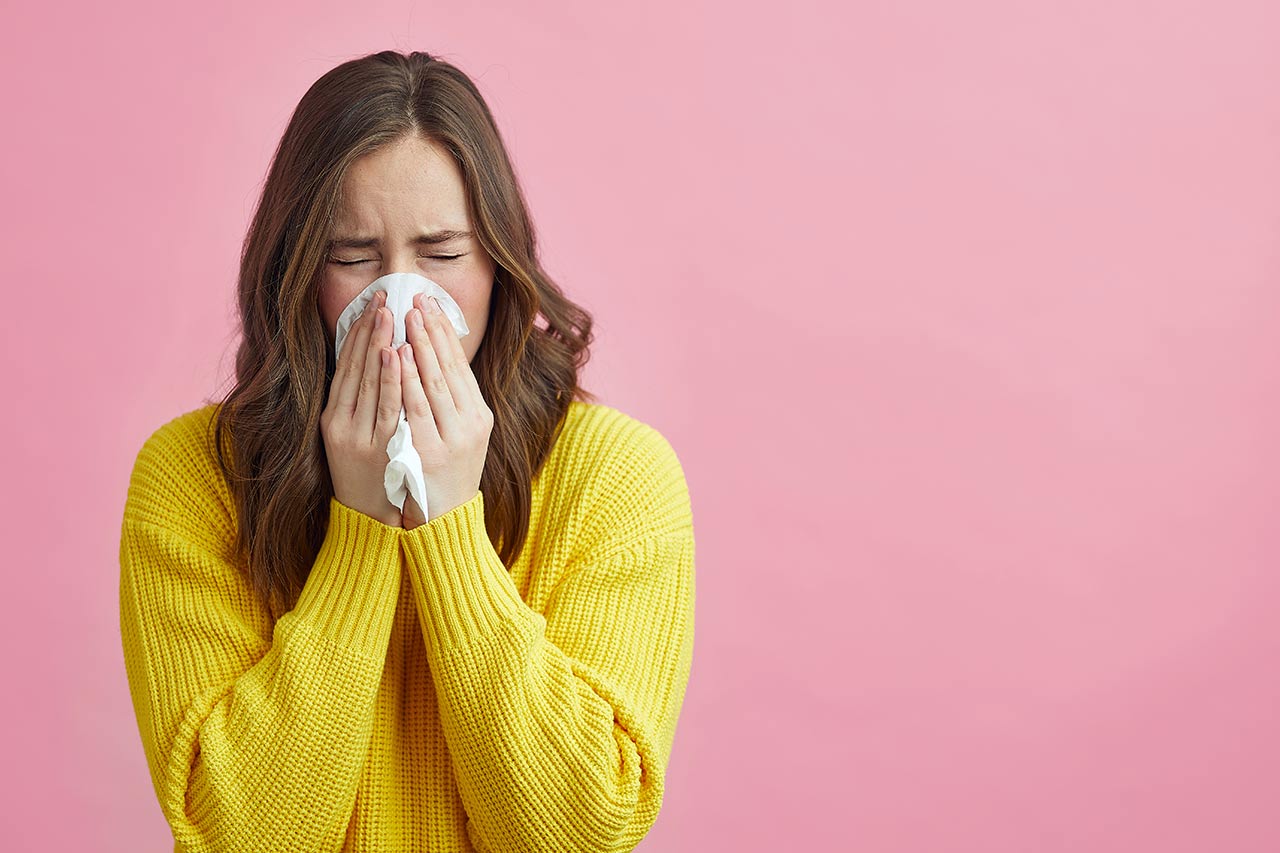Allergy is considered by the WHO as the 4th chronic disease in the world and its prevalence is constantly increasing, especially in France and in Europe. While in 1970 it was estimated at 2-3% on the national territory, it is now about 25-30%. Studies carried out on a European scale anticipate that within a few years, 50% of the population could be affected by an allergy [1]. Alcimed deciphers the explanatory factors of the continuous growth of allergy cases, and analyzes for you the stakes of allergy and the different levels of actions to consider for a better management.
The increase in allergic prevalence: a major issue explained by oversensitization to pollutants
Climate change: the main factor in the increase in allergy cases
To understand the reasons for the increase in pollen allergies in industrialized countries, we need to look at the causes of this disease. The genetic factors involved in this disease are now clearly identified, but cannot explain the current evolution of its incidence. Indeed, this would imply a durable genetic evolution within the population, which is not observable over a short period of time.
Epigenetics actually plays a key role. Indeed, if the genotype remains almost identical over the different generations, the way in which genes are expressed can evolve, for example under the influence of environmental factors. Thus, contemporary climatic changes have been identified as one of the key factors in the increase of allergies, especially in the case of respiratory allergies.
First of all, the lengthening of the seasons as well as the global increase in temperature contribute to the lengthening of pollination periods. In addition, the extent of geographical areas affected by high concentrations of pollens in the air is increasing: under the impact of global warming, species such as ragweed are spreading northwards.
Finally, a higher concentration of carbon dioxide in the air favors the production of pollens, leading to an increase in allergic symptoms for the patients concerned.
The impact of air pollution on allergies
In addition to its contribution to climate change, air pollution itself can induce allergies. Particles resulting from the massive combustion of diesel fuel can on the one hand contribute to the aggravation of allergy attacks by weakening the mucous membranes and on the other hand be responsible for allergic reactions, without the specific presence of allergens, by targeting the cells responsible for allergic inflammation of the airways. Finally, these fine particles and ozone favor the transport of allergens over long distances, increasing the geographical areas concerned by allergies.
Furthermore, studies show that early birth exposure to nitrogen dioxide (NO2) produced by diesel engines is associated with a higher incidence of asthma and allergies. This overexposure is of particular concern for young populations, as lung lining development continues into adulthood, and significant exposure to outdoor pollutants increases their vulnerability to allergies.
The deterioration of indoor air quality
The last decades have also been characterized by a continuous deterioration of the indoor air in which we live. It is estimated that indoor air is 5 to 10 times more polluted than outdoor air, while European adults spend 80% to 90% of their time in closed environments [2]. Natural allergens (dust mites, animal hair and molds) are associated with domestic pollutants (cleaning products, tobacco, etc.), which results in the development of allergic symptoms. In particular, the increase in the temperature of homes contributes to the proliferation of dust mites, and thus to the associated allergies.
Finally, early or in utero exposure of a child to tobacco smoke constitutes a major risk of allergic sensitization. The measures taken in France to limit children’s exposure to tobacco are real progress, but it is still necessary to continue to raise public awareness of these issues with an impact on allergy.
The link between changes in diet and allergies
Food allergies are also on the rise, both in terms of frequency and severity of symptoms. In 20 years, the number of anaphylactic shocks in emergency rooms has increased fourfold. [3]
The evolution of the intestinal microbiota partly explains this phenomenon. This evolution is linked to a change in diet, in particular an increased consumption of processed products. In addition, the decrease in the use of breastfeeding and the increase in the number of caesarean sections at the expense of vaginal deliveries seem to be factors linked to the increase in these food allergies. On this last point, studies have shown that the exposure of newborns to their mother’s vaginal flora could prevent them from certain allergies. It is also suggested that maternal stress may make newborns more vulnerable to allergens.
Finally, the hygienic hypothesis indicates that the decrease in the exposure of children to bacteria, in conjunction with the increased sanitization of living environments, could be a factor explaining the increasing incidence of allergies.
Challenges in improving the management of allergy
The need for training of professionals
The multiplicity and nature of the factors influencing the incidence of allergies suggest that the observed trend will continue in the future. It therefore seems key to be able to take care of all the patients concerned.
In France, it is estimated today that an allergic patient waits on average 7 years before being diagnosed. This delay can reach 15 years for patients over 60 years old. A delay in the treatment of allergies increases the risk of worsening symptoms: 30% of untreated respiratory allergies develop into asthma [4].
This diagnostic erraticity is notably linked to a lack of specialists. In France, there is one allergist for every 66,000 inhabitants, with significant heterogeneity across the country: variations range from one allergist for every 105,000 inhabitants in Normandy or Brittany to one for every 44,000 inhabitants in the Grand Est region. This worrying situation is bound to continue or even worsen, as 50% of practicing allergists are over 57 years old. There is therefore an urgent need for training on the French territory.
It is also necessary to consider “first line” health professionals, including general practitioners who are often the first to receive allergic patients. A better knowledge of symptoms and the improvement of available diagnostic tools, combined with a greater mastery of therapeutic solutions, could contribute to the improvement of the care process.
Lack of awareness of the disease
Patients have little knowledge of allergy, which limits their use of consultations. An IFOP survey conducted in 2018 for the Asthma & Allergies association revealed that 50% of French people do not consider allergy as a disease [5], which can have a negative impact on the use of consultations. The poor recognition of allergy as a disabling disease also leads patients to minimize their symptoms. Taking allergy into account in everyday life, at school or in the workplace, must therefore be a priority issue.
The challenge of integrating allergy-related issues into public policies
In total, the annual cost of allergic rhinitis in France alone is estimated at 1 billion euros, and that of hospitalizations for asthma at 0.9 billion euros [6]. It is therefore essential for health authorities to consider allergy as a major public health issue. Different tools exist and can influence both the knowledge and the incidence of allergy.
In the case of respiratory allergies, for example, the development of Regional Health and Environment Plans (PRSE) that take these issues into account can be a solution. These plans can influence the choice of vegetation present in urban areas, which has a major impact on allergic patients. Thus, certain plant species located near traffic routes can have a significant impact on the frequency of allergies. This is for example the case of cedars in Japan, which planted in areas of high concentration of fine particles, see their pollen become allergenic. Similarly, the presence of ragweed in the Rhone valley, whose pollen is highly allergenic, increases the number of allergy cases. This massive awareness of ragweed leads to expenses ranging from 59 million to 186 million euros per year according to the French National Agency for Food Safety (ANSES).
In contrast, food allergies are much better known in the public sphere. Thus, the labeling of foodstuffs specifying the allergens they contain has been mandatory in France since 2009.
Allergies in France are therefore a real social issue for public authorities, private actors and patients alike. Several strategies need to be implemented to meet the challenges posed by allergies, according to different timeframes and objectives. These actions must first of all take the form of a commitment as close as possible to patients today, by improving their care and through the development of therapeutic solutions. It is also necessary to act on a more macroscopic and long-term scale, by working on the consideration of allergy issues by public authorities, both on environmental and societal aspects. It is therefore important to bear in mind that the fight against allergies in France must be addressed globally by all the players involved.
[1] GA²LEN. Does rhinitis lead to asthma? General practitioner. Brochure 2007
[2] Combined or multiple exposure to health stressors in indoor built environments, An evidence-based review prepared for the WHO training workshop “Multiple environmental exposures and risks” 16-18 October 2013 Bonn, Germany
[3] For a five-year allergy control plan, 2022-2027
[4] https://asthme-allergies.org/faits-chiffres-comprendre-lallergie/
[5] IFOP survey of 1002 adults from 21 to 23 February 2018
[6] Scientific and technical support note from the French National Agency for Food, Environmental and Occupational Health Safety on the phenological monitoring of pollen in ambient air and the pollen exposure-related allergy risk indicator (RAEP), 01/2022.
About the author,
Marie, Consultant in Alcimed’s Healthcare team in France



